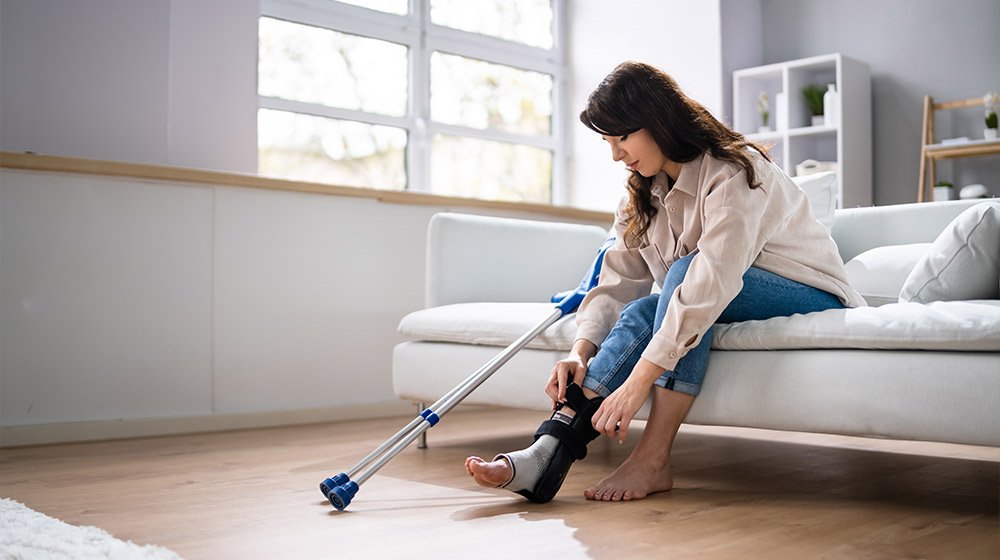Overview
Fractures, or broken bones, are common injuries that various reasons can cause. While surgeries and rehabilitation programs can help patients regain normal mobility and functioning, injury detection and treatment delay may lead to irreversible damage.
This article aims to provide information about a type of bone break called comminuted fractures, how doctors and surgical technicians typically treat the injury, and the latest findings in comminuted fracture treatment.
RELATED: Rheumatoid Arthritis: Causes, Symptoms & Treatment
Comminuted Fracture: a Severe Type of Bone Break That Affects a Wide Range of Populations
What is a Comminuted Fracture?
A comminuted fracture is a break of a bone that results in shattered fragments of bone at the injured site. It is typically caused by a significant physical impact and is considered a severe bone break. Surgery is almost certainly required in treating comminuted fractures, and recovery can take a year or longer.
Some areas that are most vulnerable to a comminuted fracture include:
- Thigh bone
- Kneecap
- Shinbone
- Forearm
- Wrist Joint
- Collarbone
1. Comminuted Fractures and Segmental Fractures

A comminuted fracture is distinct from a segmental fracture. The broken area is shattered into several small pieces in a comminuted fracture. On the other hand, in a segmental fracture, the damaged area is separated by a large, detached section of the bone.
2. Open and Closed Comminuted Fractures
An open or closed comminuted fracture is how doctors describe the severity and complexity of the fracture.
An open comminuted fracture is when the bone breaks through the skin and protrudes outward. The protrusion of the bone makes this type of fracture more severe and more likely to lead to infection. A compound fracture is another term for an open comminuted fracture.
A closed comminuted fracture is when the bone breaks inside the injured area without bone protrusion. This type of fracture is less severe and takes less time to recover. However, both types of injuries require prompt medical care and intensive recovery.
3. Displaced and Nondisplaced Comminuted Fractures
A comminuted fracture can be either displaced or nondisplaced from the alignment during the break.
If the fracture is displaced, the bone pieces move so much and leave a gap around the fracture. If the fracture is nondisplaced, the fragments of the bone still move, but to a lesser extent, and are not out of alignment.
What Are the Symptoms of a Comminuted Fracture?
1. Common Symptoms
- Pain, swelling, or bruising
- Protrusion in the affected area
- Inability to move the injured area
2. Severe Complications
- Dizziness
- Nausea
- Faintness
- Infection
3. When Should You Go to the Emergency Room?
You should seek medical attention immediately if you suspect you have a comminuted fracture or other broken bone. If you suffer any of the following, head to the emergency room:
- Intense pain that goes with swelling or bruising
- Tenderness when pressing on the part of your body
- Inability to move a part of your body
- An area of your body is dislocated or out of normal shape
What Causes a Comminuted Fracture?
1. Serious Physical Impact
Healthy bones are typically solid and resilient enough to endure average physical impact, like a slip or a fall. However, a more intense force due to a car accident or a fall from a great height may cause a comminuted fracture.
2. Underlying Health Conditions
Older people may be more susceptible to a comminuted fracture, especially with bone diseases like osteoporosis or bone cancer.
Menopausal women are also more likely to experience the injury due to a drop in estrogen, which plays a significant role in maintaining bone formation at the cellular level.
RELATED: Is It Possible to Prevent Bone Loss? Causes, Symptoms & Treatment
How Is a Comminuted Fracture Diagnosed?
1. Physical Examination
First, your doctor will inspect your injured area to determine whether the tenderness, pain, or immobility is due to a broken bone.
2. Imaging Tests
Your doctor will also have you undergo imaging tests, including an X-ray, CT scan, or MRI, to ensure the accuracy of the initial physical examination.
- An X-ray shows how damaged the fractured bones are.
- A CT scan gives the surgeon a more detailed picture of the broken bone and the surrounding tissues.
- An MRI shows how the injury affects the muscles, connective tissues, and organs.
How to Treat a Comminuted Fracture
1. Internal Fixation
The fundamental approach to repairing a broken bone is realigning and securing the bones in their correct position by installing metal rods, plates, screws, or nails. This technique is called internal fixation.
To implant these pieces of metal into your bone, surgeons will make an incision at the injured area, attach the screws along the broken section, and secure the screws with a long nail in the center of the bone. This internal metal structure helps support the bone until it heals.
2. External Fixation
Sometimes, internal fixation is attached to a frame outside of the broken bone, called external fixation. This method stabilizes the fracture while other injuries heal and is often a temporary measure.
Your surgeon will connect the screws attached to the broken bone with a brace around the bone outside your body. Another method is traction, which uses weights, pulleys, and ropes to gently exert pressure and draw the broken bone back into the correct position.
A cast or a splint may also be used in treating a comminuted fracture. These orthopedic devices stabilize the shattered bone and stop the surrounding tissue from moving as it heals. Casts and splints can also relieve the discomfort by preventing or reducing muscle contractions.
3. Bone Grafting
Bone grafting is inserting additional bone tissue into the severely displaced fracture. This method is necessary if the injury is too severe to the point the surgeon expects it to take a prolonged amount of time to heal. Bone grafting is usually done in the first phase of the surgery, followed by internal fixation.
Bone grafts come from the following sources:
- Internally from your bone
- A donor
- An artificial replacement piece (prosthesis)
4. Medications
You may also be prescribed some pain relievers during comminuted fracture treatment, such as:
- Acetaminophen (Tylenol)
- Ibuprofen (Advil, Motrin IB)
However, remember that pain relievers may lead to bleeding and some complications after surgery. On this account, please consult your doctor before taking any medication.
What Questions Should You Ask Your Doctor?
1. Which Bones Are Fractured?
Accurately detecting the presence of an injured site is vital to promptly and effectively treat a comminuted fracture.
According to a case report published by the Cureus Journal of Medical Science, a young adult who suffered from elbow pain and swelling due to a comminuted fracture only presented to a doctor three weeks after the injury.
Although the surgery succeeded, the report emphasizes the importance of timely diagnosis and treatment for fractures, especially those typically challenging to detect.
2. Which Type of Surgery Do I Need?
Consult with your surgeon to determine which type of surgery you will need. The type of the operative technique will primarily affect the outcome of your treatment and the time it takes to recover. Some common types of surgery include:
- Surgery to install plates
- Surgery to install screws
- Surgery to install nails or rods
- Surgery to install wires or pins
3. Will I Need Follow-up Operations?
Most of the time, the initial surgery for installing the supportive metal pieces into the comminuted fracture will be followed by a later surgery for metal piece removal.
4. How Long Will It Take to Recover?
Most comminuted fractures will take at least a year or longer to recover. How much time you need to regain normal functioning of the fractured area will depend on the injury’s severity and complexity. Other factors related to the recovery time include fracture care and your level of mobility.
Recent Findings in Comminuted Fracture Treatment
1. Combined Osteosynthesis and Repair of the Patellar Tendon Can Treat Comminuted Fracture of the Kneecap
According to a report by the Department of Orthopedic, Sohag Teaching Hospital, osteosynthesis (a surgery to treat bone fractures) and correction of the patellar tendon avulsion can successfully treat kneecap fractures.
This technique can also reduce the need for a surgical procedure to remove the kneecap and increase the chance of preserving the original length of the bones. The report also mentions that the new surgical technique allows immediate full weight-bearing and early, extensive rehabilitation programs.
2. Surgery Using a Prosthesis Can Treat Comminuted Fracture of the Shinbone
Research by the Journal of Orthopedics found that an innovative prosthesis design, which consists of two shell valves attached by a central pin, can be used to treat comminuted fractures of the shinbone. This orthopedic device ensures both the structural stability of the bone and the circulation of bodily fluids.
The research concluded that the new operative technique results in good overall resistance and stability of the prosthesis, which offers an optimal solution for elderly patients who cannot undergo complex surgery.
3. Surgery Using a Lateral Locking Compression Plate Can Treat Comminuted Fracture of the Thigh Bone
According to a case report by the Annals of Translational Medicine, a treatment procedure that consists of temporary external fixation using traction and surgery to install a minimally invasive compression plate can treat comminuted fracture of the thigh bone.
This operative technique did not result in any postoperative complications. The patient showed good limb function at the 3-year follow-up. On this account, this approach opens up new surgical options for orthopedic surgeries. It should be considered for the precise repair of comminuted fractures of the thigh bone.
4. Surgery Using a Headless Compression Screw Can Treat Comminuted Fracture of the Wrist Joint
Another case report showed that a comminuted fracture of the wrist joint, a rare injury occurring in fewer than 4% of all hand fractures, can be treated by surgery using a screw attached to the area between the base of the thumb and the wrist joint.
Bottom Line: How Are Comminuted Fractures Affecting Adults?
Comminuted fractures, due to their particular severity and complexity and subsequent requirement for invasive treatment like surgery, can cause severe and debilitating damage to the injured person.
However, according to the U.S. Department of Health & Human Services, only a small percentage of older adults experience fractures due to significant trauma. It is because most fracture occurrences among the elderly population are caused by either moderate trauma or pathological causes like osteoporosis.
In contrast, young adults without bone diseases are more likely to suffer severe fractures due to significant trauma, like motor vehicle accidents or falls from a great height. For this reason, not only the older adults but also, the younger population should take more caution against incidents that can cause comminuted fractures.
References
Khosla, S., Oursler, M., Monroe, D. (2012). Estrogen and the Skeleton. U.S. Department of Health & Human Services.
Massoud, E. (2017). Repair of Comminuted Fracture of the Lower Patellar Pole. Department of Orthopedic, Sohag Teaching Hospital.
Farr, J., Melton, L., Achenbach, S. et al. (2017). Fracture Incidence and Characteristics in Young Adults Age 18 to 49 Years: a Population-based Study. U.S. Department of Health & Human Services.
Filardi, V. (2019). Healing of Tibial Comminuted Fractures by the Meaning of an Innovative Intramedullary Nail. Journal of Orthopedics.
Sehgal, A., Shahi, P., Bansal, K., Zafar, A., Pathak, S. (2020). Neglected Comminuted Fracture of the Capitellum. Cureus Journal of Medical Science.
Liu, H., Yuan, B., Yu, T. et al. (2020). Accurate Fixation of Complicated Comminuted Femur Fracture With Customized LCP Referencing a Life-size 3d-printed Model: a Case Report. Annals of Translational Medicine.
Spielman, A., Sankaranarayanan, S. (2021). Comminuted Trapezium Fracture: Case Presentation and Review of Surgical Fixation Techniques. Case Reports in Orthopedics.
If you have questions about comminuted fractures or any health problems discussed here, connect with us and learn more.
At Peak Human, our team of healthcare professionals is dedicated to helping you reach your ‘peak’ health with a custom whole-person approach. Using the most cutting-edge, science-backed biohacking and aesthetic tools, technologies, and treatments available today, we help you achieve the highest physical/cognitive performance state, leading to an improved overall quality of life.
For questions or to book an appointment, don’t hesitate to contact us. Get personalized support and insight from expert physicians.
UP NEXT:
- 5 Benefits of High-intensity Interval Training
- 5 Best Anti-aging Foods for Gut Health
- Male Pattern Baldness: Causes, Symptoms & Treatment









